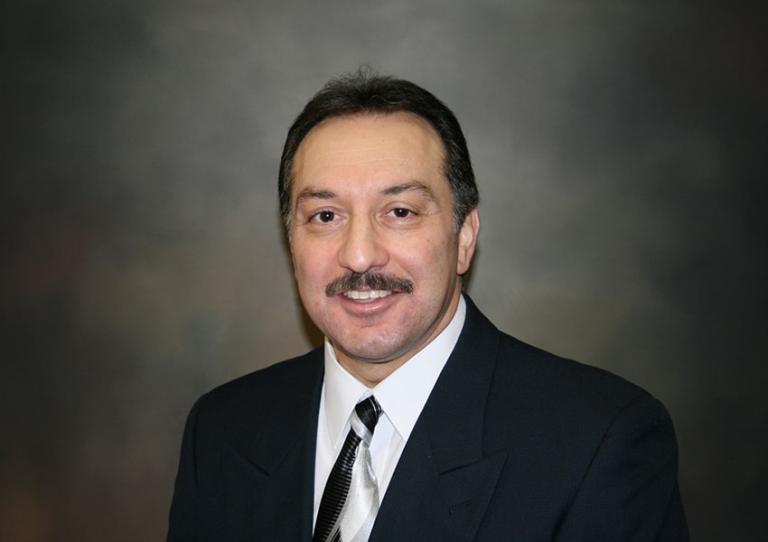
Working on making diesel engines more environmentally friendly and efficient, Dr. Bassem Ramadan professor of Mechanical Engineering, and two graduate students are researching improvements to the insulation on diesel catalytic converters and adding urea to the exhaust system to reduce NOx emissions.
In one of the two research projects, Timothy Sullivan, a graduate student from Grand Blanc, is putting catalyst substrate or catalyst brick mat material through a series of tests to determine why it sometimes fails, what affects it and what characteristics it needs to have for robust performance.
The mat material is a spongy material put between the catalyst substrate and the metal casing of a catalytic converter. Under certain conditions, the metal casing can expand and cause the substrate to vibrate and break which can result in failure of the catalytic converter. "We are looking at this material to determine its mechanical characteristics and its expansion and contraction characteristics," said Ramadan, "how do heat, moisture, mechanical stress, and vibrations affect it?"
Delphi currently relies on suppliers to define this material, according to Ramadan. "They have funded this research to better understand the mat material and be able to select the right material that can be used in the catalytic converter," he said.
The composition of elements varies in different composite materials used for the mat material. The material is not homogeneous, but is made up of multiple substances with many different types of fibers.
Currently, Sullivan is running tests on mat material samples including compression testing in which he crushes samples of the material, calculating based on the basis weight and the surface area using a materials testing machine that can exert 500 pounds of force.
Kettering has purchased a larger materials testing machine that can exert 7.5 kilo-Newtons, or1700 pounds of force, for further testing. The larger machine adds an additional "twist" to their research capabilities because it has an upper plate that can rotate, allowing further testing variables such as shear (twisting or rotating).
Delphi and Ramadan have chosen to use testing machines with electric motors versus those that use hydraulic motors. The electric motors are better for this type of testing, according to Ramadan, because they produce less noise and vibration than hydraulic motors, and offer better control with faster and higher amplitude.
Delphi is interested in determining what basis weight of mat material works best under pressure and heat. Sullivan will use a furnace that can heat the samples to 800-900 centigrade to determine if temperature affects the material's performance and also perform testing with the top plate and the bottom plate at different temperatures. They are also going to study the effects of moisture content on the material.
Following initial testing, he and Ramadan are going to perform mathematical modeling using the test results to predict behavior under varying conditions, such as fatigue. One of the more common causes of fatigue is oscillation of load, which can cause the material to break. Ramadan and Sullivan want to identify the frequency and load that result in breakage.
The other project being overseen by Ramadan involves looking at how exhaust gases flow through a catalytic converter to better understand their flow characteristics and pressure drop. "When using a diesel system there is more concern about nitrogen oxides," said Ramadan.
Exploring one way to reduce nitrogen oxides, or NOx, Phillip Lundberg a graduate student from Kokomo, Ind., will use a Computational Fluid Dynamics (CFD) model to determine the flow characteristics in exhaust systems and catalytic converters to eventually understand how to introduce urea into the exhaust system of a diesel vehicle with a catalytic converter.
"Diesel particulate filters (DPF) collect particles that create black smoke associated with diesel exhaust," Ramadan said, "NOX can be controlled by controlling temperature and by using a catalytic converter. However, catalytic converters don't work as well with diesel engines as with gasoline engines for reducing NOx.
"One reason is that diesel exhaust has a lower temperature and is usually the result of lean combustion. Catalytic converters work better at higher temperatures and with stoichiometric combustion. Moreover, diesel fuel contains sulfur that can poison the catalytic converter," he said. "The idea behind this project is to have a urea tank from which urea is injected as a liquid into the exhaust pipe ahead of the catalytic converter so it can evaporate and mix with the exhaust to create a chemical reaction that will reduce NOx," said Ramadan.
Urea is an organic compound of carbon, nitrogen, oxygen and hydrogen, with the formula (NH2)2CO. It is also known as carbamide, especially in Europe. It was the first organic compound to be artificially synthesized from inorganic starting materials. It is found in mammalian and amphibian urine as well as in some fish.
Urea produces ammonia, which reacts with NOx to produce nitrogen and water. "If introduced into the system properly, there will not be any ammonia in the exhaust," Ramadan said. "We are trying to establish what needs to be done to control the urea so that it reacts properly in the exhaust".
"We are looking at such issues as where to inject the urea into the exhaust system and what conditions are needed to perfect the process. Typical studies look at how to spray it, the spray pattern, droplet size, different locations in the exhaust for injection and how it all affects its distribution," he added.
Lundberg will be performing mathematical simulations to simulate the physics of fluid flow and the chemical reactions that may occur upon the introduction of urea into the exhaust system. "If we can achieve the correct balance, we should only see nitrogen and water in the exhaust," said Ramadan.
Delphi, headquartered in Troy, Mich., is a leading global supplier of mobile electronics and transportation systems, including powertrain, safety, steering, thermal, and controls & security systems, electrical/electronic architecture, and in-car entertainment technologies.
Written by Dawn Hibbard
810-762-9865
dhibbard@kettering.edu